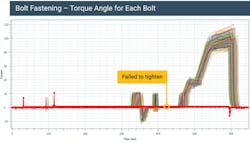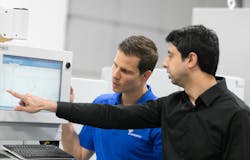Why should you as a machine builder/integrator care about incorporating data collection and analysis capability into your production process?
It’s a valid question, and one that is easy to answer if your customer has made such capability a requirement of the build. We explored that aspect of it last spring in an article titled “How to Stay Competitive in a Connected Revolution."
In that article, we talked about how Manufacturing 4.0/Industry 4.0 is driving the need for manufacturers to make more effective use of their production data to raise the bar on quality, yield, and traceability. It’s much easier for a manufacturer to have this intelligence incorporated into a line as it is being built than bolted on afterward. Most would rather purchase a complete turnkey solution from a machine builder than incur the time and expense of procuring equipment, hardware, and software from different vendors, and then trying to integrate it themselves.
1. Machine builders can carry out digital process signature and other data analysis as manufacturers do with process and test data from the production line to quickly catch anomalies that point to specific issues with the build. This reduces the odds of cost overruns, missed deadlines, and unhappy customers.
Raise the Bar on OEE
But what is the business case for a machine builder/integrator to make this same kind of technology investment, internally, to raise the bar on its own manufacturing and fabrication processes, when it is not included in the project specs from a customer?
We appreciate that machine builders and integrators work under stiff constraints: Build it fast and build it cheap, because the margins are too thin to do much else. The customer isn’t interested in paying for add-ons and capabilities outside off its specs. It’s one thing for a manufacturer to require an integrator include data collection and analysis capability in a build, quite another for the integrator to sell the idea to a manufacturer that hasn’t already embraced an Industry 4.0 strategy.
On the other hand, machine builders and integrators are on the hook for OEE (Overall Equipment Effectiveness)—will the build meet the customer’s gold standard for manufacturing only good parts, as fast as possible, with no stop time?
This raises important questions:
- What quality control benchmarks are employed in your shop to ensure the build will meet the OEE requirement?
- How can you make the grade for OEE faster and more reliably?
It All Rests with a Serial Number
The key is to do what many Industry 4.0 manufacturers are already doing. They are turning to off-the-shelf, vendor-agnostic digital process monitoring equipment and software to collect all relevant data for each process and test cycle on the production line. All this data is then integrated into a comprehensive birth history record, serialized by part/assembly.
These records are then stored in a single database where they can be correlated and analyzed by anyone—anywhere in the organization, at any time—for traceability and root cause analysis. The goals are to reduce scrap and rework rates, boost FTY, limit the scope of warranty claims and recalls, and provide proof of compliance.
A machine builder/integrator can make the same technology investment to realize similar benefits, which could ultimately cut costs, shorten build times, and raise the bar on OEE.
2. Start small and grow. It isn’t feasible to rip everything out and start green. Find a trouble spot where a fix will have the largest impact and find the least intrusive way to implement it for a proof of concept.
Baby Steps are Best
We are not suggesting that a machine builder/integrator absorb the cost of equipping a build with an array of digital equipment that remains embedded. Instead, employ those off-the-shelf process monitoring tools as a manufacturing would—connect them to the build/assembly for process verification and quality assurance, then disconnect when complete. This kind of technology doesn’t have to be embedded, any more than it is on a manufacturer’s production line as parts and assemblies proceed through each process and test station. It is the station, not the part/assembly in production, that is equipped with this data collection and analysis capability.
As with any initiative to integrate new technology, there will always be a certain degree of resistance among the team. A desire to do better gets stuck in that comfortable rut called the status quo. The key to success is start small and achieve a convincing proof of concept by addressing a single trouble spot. In this case, focus on an aspect of a build that routinely causes OEE performance problems and wastes valuable time to address.
A Check Against What Can Go Wrong
Maybe it’s a press-fit or a torque-to-turn operation. Whatever the case, there is always some issue with achieving the proper calibration or some other parameter, such as alignment, pressure, or angle.
With commonly available process monitoring tools, it’s possible to trace, in production real-time, the source of the problem. These tools allow builders to draw a picture from the scalar data, as well as the digital process signatures (waveforms such as sensor curves that capture and plot hundreds of thousands of data points per process or test cycle). This provides immediate visibility into the impact of part and process variations, and the interaction between processes. It allows for parts to be re-tested in a virtual digital environment.
All this takes the guesswork and trial-and-error out of troubleshooting a problem. It shouldn’t take long for the ROI to be self-evident. Then expand to the next trouble spot that’s causing your team grief. By staring small, the initial cost of this new technology investment is kept to a minimum, amortized over several builds and quickly recouped.
But What About All That Data?
This approach to a machine build and integration does have an obvious consequence—you do need to employ some means to organize and archive all the resulting data. Some people might say it doesn’t have to be kept; once the build is complete and delivered to the customer, just dump those birth history records.
But we contend that these records can and should be retained for very practical and beneficial reasons:
Process improvement for future builds. We have seen countless examples of this on the manufacturer’s side, where the time to troubleshoot and dial-in new lines and new stations was dramatically reduced. Days and weeks reduced to hours and even minutes.
For a builder/integrator, there is a huge opportunity to improve the quality and performance and find faster and cheaper ways to complete the build without sacrificing quality. The opportunity for improvement doesn’t have to result from an obvious problem, just having the data-driven insight to make what is good, better.
Using algorithms to search for anomalies that were not significant enough to raise a red flag during the build may identify the need to adjust process and test limits. It may also pinpoint other builds already deployed with customers that may need preventative maintenance or repair before the customer is complaining about unexpected downtime.
Reducing liability and warranty issues. The data can be kept to provide traceability if a performance issue arises later on the customer’s line. This helps you as the machine builder reduce your exposure to warranty issues. A data trail is key to avoid those finger-pointing situations where a customer attempts to lay all the blame for a problem on the quality of your build when the real issue may be normal wear and tear, operator error or lack of proper maintenance on their part.
3. Finding the data that will yield the biggest benefit can be like asking which came first: the chicken or the egg? You need to pick one clear subset of your data as a starting point to understand the story that data from any stage of the build can tell.
Deliver Faster…and Better
Ultimately, incorporating modern data collection and analytics into a build or integration only makes sense if it meets the ever-present requirements to be as lean as possible, in terms of both time and cost.
With the third-party options available today, it is increasingly easy to add intelligence to the process of the build to shorten time to completion, deliver to the customer a more reliable system that will meet (or exceed) required OEE benchmarks, and provide the builder/integrator with a data resource that will drive continuous improvement and reduce its liability.
Derek Kuhn is senior vice president of Sciemetric. He brings substantial experience in the automotive market and in the trends and technology associated with the Internet of Things (IoT). Aaron Alberts is global accounts manager of Sciemetric. He has 14 years of experience working with automotive, industrial diesel, and aerospace customers.




